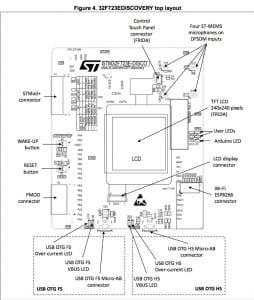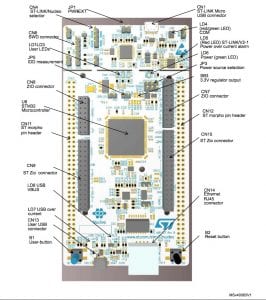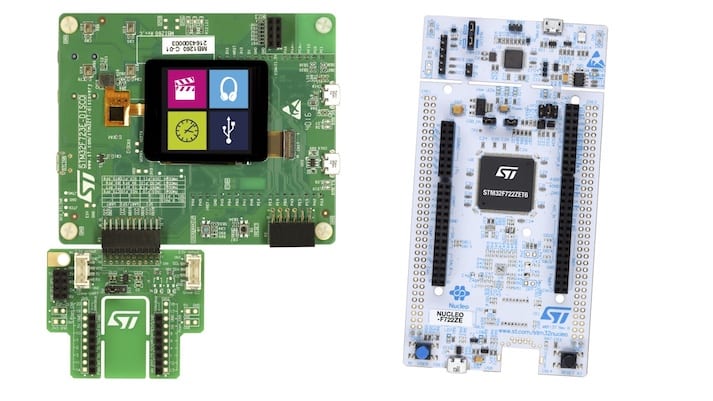Update April 17, 2019
ST released a few weeks ago the STM32F7 workshop MOOC, a series of hands-on videos to help professionals and enthusiasts use their STM32F7 Discovery board to their fullest. The MOOC (Massive Open Online Courses) focuses on the 32F746GDISCOVERY, but the vast majority of videos apply to the other STM32F7 Discovery kits as well, such as the 32F723EDISCOVERY, since they deal primarily with the microcontroller, and use example code to show the component’s features. For example, the video below will help engineers test the benefits of using the available cache. The courses even walk the audience through the import of the source code into the test IDE (IAR EWARM with a 30-day license) and the steps necessary to upload the application to the MCU.
A list of the course’s requirements is available in the video’s description and the “Hands_on” file used during the course is available online. The tutorials will even go into the use of the memory protection unit (MPU), the use of DSP algorithms to process data from sensors and even applications using Fast Fourier Transform. There are also classes on STM32CubeMX to help engineers take advantage of our MCUs. Students will thus leave with a deep understanding of the architecture, our solutions, and how they can turn ideas into viable products faster.
- Check out the STM32F7 workshop MOOC
Original Text: February 28: 2017
The 32F723EDISCOVERY (left) and NUCLEO-F722ZE (right) are the latest development boards from ST using a Cortex-M7 microcontroller (MCU). Last year, the STM32H7, became the most potent Cortex-M7 MCU capable of breaking the 2000-point threshold in CoreMark. The STM32F7 processors in those new board are not as fast, but still, share a lot of the structural similarities that make them high-end mobile processors. Too often, these types of boards tend to be underpowered, limiting the scope of what engineers can prototype. The two new ST platforms offer a lot more horsepower than traditional solutions, without sending the power consumption through the roof.
Versatility

32F723EDISCOVERY is the most versatile STM32F7 Discovery board yet, thanks to its many connectors: ESP–01 Wi-Fi, Arduino Uno V3, PMOD, and the new STMod+. The PMOD (Peripheral Module) interface can be used by fundamental modules, or more complex peripherals like LCD displays, network adapters, or digital to analog converters. It can carry SPI signals, or other serial protocols, to enable the addition of low-frequency modules.
Beside the PMOD, ST added its first STMod+ connector. Using 2 x 10 pins, it can carry +5 V to power a USB port or a battery. ST is first going to use it in a Fan-Out board for the 32F723EDISCOVERY that could connect to a breadboard. By offering this level of flexibility, ST aims to have a solution that becomes the smoothest road to experimentation. The integration of so many interfaces under “one roof” means engineers will be more likely to already have some or all of the components they need to start their project, instead of ordering and waiting to receive something compatible.
The Power of a Cortex-M7 Made More Accessible

The 32F723EDISCOVERY is similar to the other STM32F7 Discovery Boards already available, like the 32F769IDISCOVERY, and 32F746GDISCOVERY. We find four ST-MEMS microphones, two push buttons (user and reset) for easy application interactions, and lines for audio input (external mic), output (headphone jack), or stereo speakers. Its MCU, the STM32F723IEK6, has a floating-point unit, and the Adaptive Real-Time Accelerator found in many of ST’s chips, to optimize code execution, and increase performance, as seen on applications like 3D printing.
As a result, the new board primarily targets multimedia and computationally intensive applications. Its 240 x 240 capacitive touch screen will prove invaluable as developers test various interactive features. Furthermore, because rendering happens by reading and writing data from the RAM, without any external clock operation, the electrical consumption resulting from the use of the display remains trivial. Hence, it becomes possible to benefit from basic graphical interfaces, read system messages and logs, or create prototypes with an embedded display, without much impact on the overall power draw.
Simpler Design

The NUCLEO-F722ZE is very similar to the NUCLEO-F767ZI, but omits its Ethernet port, offering an alternative to those who would never use the interface in their design. Indeed, using the Ethernet port and the ST Zio connector could sometimes lead to conflicts between specific shared resources. The ST Zio is an extension of the Arduino Uno connector enabling the use of a broader range of modules. By taking the Ethernet port out, the F722ZE dramatically facilitates the life of engineers, since they won’t have to solder or remove certain bridges to ensure an expansion board runs properly. For instance, the new design will be particularly useful if users know they are going to use a Wi-Fi module, like the X-NUCLEO-IDW01M1.
The board’s MCU, the STM32F722ZET6, also includes an on-chip USB High-Speed OTG (On-The-Go) controller, just like in the microcontroller found on the 32F723EDISCOVERY. As a result, engineers working with both of these development boards can write applications that take advantage of this physical layer, without worrying about additional components. Since the OTG standard allows peer-to-peer connections without having to go through a computer, it becomes possible to easily create accessories that will plug to the STM32F7 device to enhance the user’s experience.
This Nucleo–144 board remains the most comfortable option to start prototyping on an STM32F7 MCU and still enjoy the vast amount of compatible expansion boards and application code already in the wild. Its support of the mbed development platform also means engineers can start experimenting with very little personal and financial investment. Finally, since most of the MCU’s I/O signals are accessible through the Zio connector, it remains an excellent starting point to create custom products. 32F723EDISCOVERY and NUCLEO-F722ZE are already available at $39 RRP or $19 RRP respectively.




